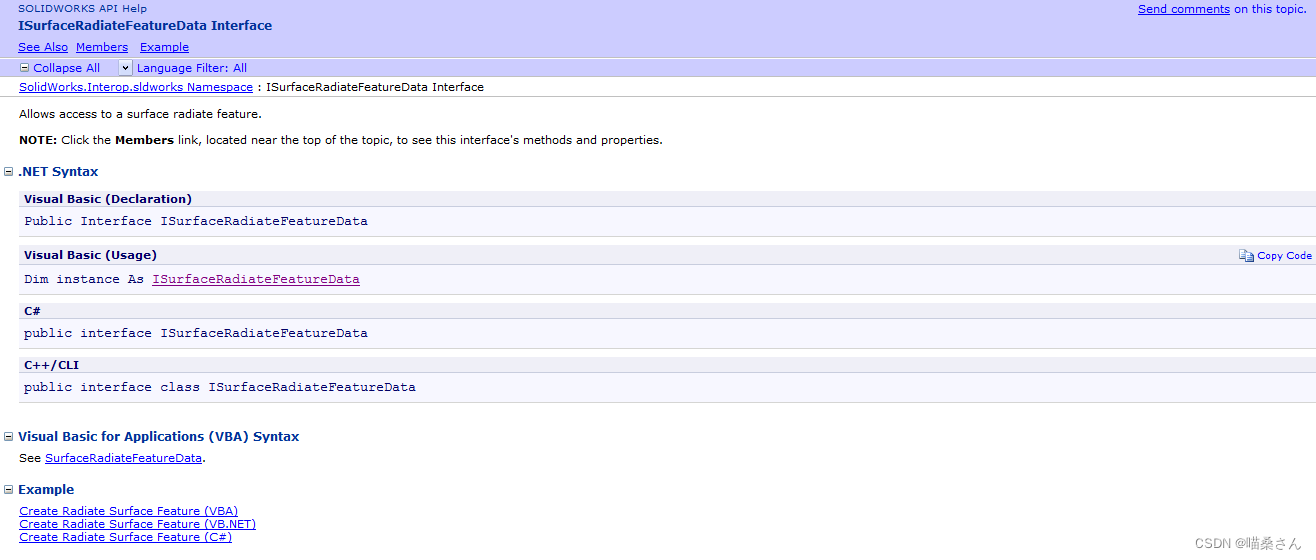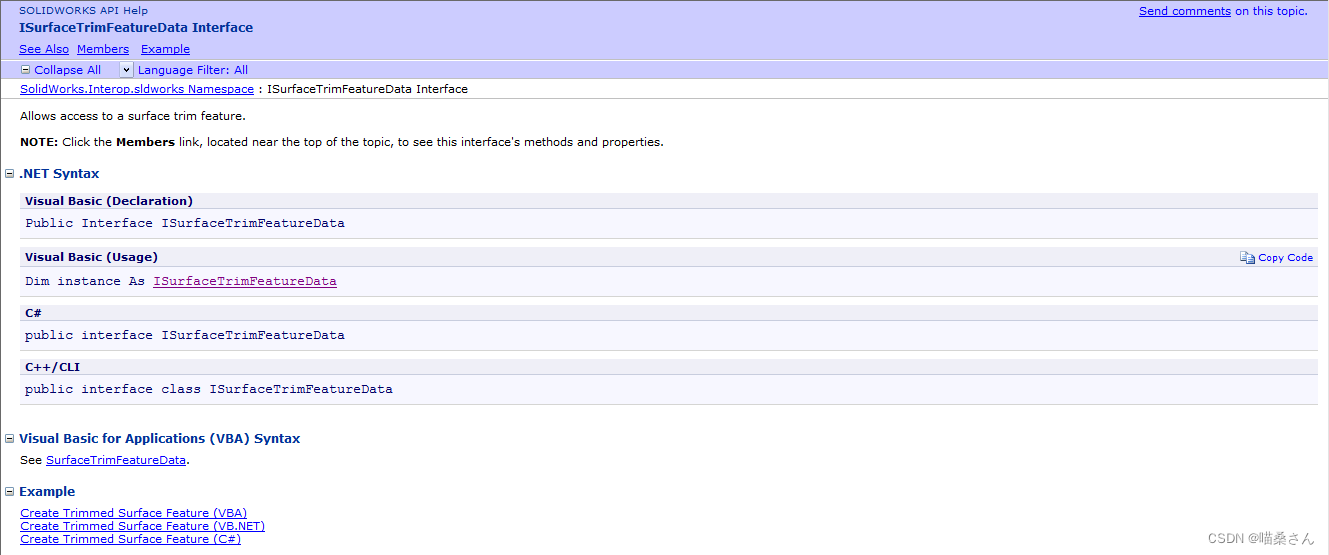大家好,今天要介绍的是关于平面、曲面相关的API。
下面是相关的API:
(1)第一个为ISurfacePlanarFeatureData,这个API的含义为允许访问平面表面特征,下面是官方的具体解释:

下面是官方使用的例子:
This example shows how to create a planar surface feature.
//----------------------------------------------------------------------------
// Preconditions:
// 1. Verify that the specified document template exists.
// 2. Open an Immediate window.
//
// Postconditions:
// 1. Creates a new model document with a boss extrusion.
// 2. Creates Surface-Radiate1 and Surface-Plane1 in the FeatureManager
// design tree.
// 3. Inspect the Immediate window.
//----------------------------------------------------------------------------
using Microsoft.VisualBasic;
using System;
using System.Collections;
using System.Collections.Generic;
using System.Data;
using System.Diagnostics;
using SolidWorks.Interop.sldworks;
using SolidWorks.Interop.swconst;
using System.Runtime.InteropServices;
namespace CreateSurfacePlaneFeature_CSharp.csproj
{
partial class SolidWorksMacro
{
ModelDoc2 Part;
SelectionMgr swSelMgr;
SelectData swSelData;
SurfaceRadiateFeatureData swRadiate;
SurfacePlanarFeatureData swPlane;
Feature swFeat;
Entity swEnt;
object[] vRadEnt;
object[] vBoundEnt;
Entity swRadDirEnt;
int i;
bool boolStatus;
public void Main()
{
Part = (ModelDoc2)swApp.NewDocument("C:\\ProgramData\\SolidWorks\\SOLIDWORKS 2015\\templates\\Part.prtdot", 0, 0, 0);
Part = (ModelDoc2)swApp.ActiveDoc;
boolStatus = Part.Extension.SelectByID2("Front Plane", "PLANE", -0.0448901407839529, 0.0279954694016864, 0.00466820674117181, false, 0, null, 0);
Part.SketchManager.InsertSketch(true);
Part.ClearSelection2(true);
boolStatus = Part.Extension.SetUserPreferenceToggle((int)swUserPreferenceToggle_e.swSketchAddConstToRectEntity, (int)swUserPreferenceOption_e.swDetailingNoOptionSpecified, false);
boolStatus = Part.Extension.SetUserPreferenceToggle((int)swUserPreferenceToggle_e.swSketchAddConstLineDiagonalType, (int)swUserPreferenceOption_e.swDetailingNoOptionSpecified, true);
object vSkLines = null;
vSkLines = Part.SketchManager.CreateCornerRectangle(-0.0555749908365768, 0.0329075527136081, 0, 0.0478203409524033, -0.0317145296545045, 0);
Part.ClearSelection2(true);
Part.SketchManager.InsertSketch(true);
Part.ShowNamedView2("*Trimetric", 8);
Part.SketchManager.InsertSketch(true);
Part.ClearSelection2(true);
boolStatus = Part.Extension.SelectByID2("Sketch1", "SKETCH", 0, 0, 0, false, 4, null, 0);
object myFeature = null;
myFeature = Part.FeatureManager.FeatureExtrusion2(true, false, false, 0, 0, 0.00254, 0.00254, false, false, false,
false, 0.0174532925199433, 0.0174532925199433, false, false, false, false, true, true, true,
0, 0, false);
boolStatus = Part.Extension.SelectByID2("", "EDGE", -0.0447337592343047, 0.0328467250718631, 0.00258132540182032, false, 2, null, 0);
boolStatus = Part.Extension.SelectByID2("", "EDGE", -0.0556265649287866, 0.0156695101210289, 0.0025672149453726, true, 2, null, 0);
boolStatus = Part.Extension.SelectByID2("", "EDGE", -0.0140113588298618, -0.0317157034173761, 0.00254079743683633, true, 2, null, 0);
boolStatus = Part.Extension.SelectByID2("", "EDGE", 0.047780958393389, -0.00542256709667299, 0.00256078163948814, true, 2, null, 0);
boolStatus = Part.Extension.SelectByID2("", "FACE", 0.0478203409524554, -0.00305747564971171, 0.000546558985774936, true, 1, null, 0);
Part.InsertRadiateSurface(0.0254, false, false);
swSelMgr = (SelectionMgr)Part.SelectionManager;
swSelData = swSelMgr.CreateSelectData();
boolStatus = Part.Extension.SelectByID2("Surface-Radiate1", "REFSURFACE", 0, 0, 0, false, 0, null, 0);
swFeat = (Feature)swSelMgr.GetSelectedObject6(1, -1);
swRadiate = (SurfaceRadiateFeatureData)swFeat.GetDefinition();
// Get radiate surface data
Debug.Print("File = " + Part.GetPathName());
Debug.Print(" " + swFeat.Name);
Debug.Print(" Distance: " + swRadiate.Distance * 1000.0 + " mm");
Debug.Print(" Flip? " + swRadiate.Flip);
Debug.Print(" Propagate to tangent faces? " + swRadiate.PropagateToTangentFaces);
// Roll back to get direction reference and radiated edges
boolStatus = swRadiate.AccessSelections(Part, null);
swRadDirEnt = (Entity)swRadiate.DirectionReference;
Part.ClearSelection2(true);
vRadEnt = (object[])swRadiate.RadiatedEntities;
Debug.Print("Type as defined in swSelectType_e:");
for (i = 0; i <= swRadiate.GetRadiatedEntitiesCount() - 1; i++)
{
swEnt = (Entity)vRadEnt[i];
Debug.Print(" Radiated Entity(" + i + ") = " + swEnt.GetType());
}
swRadiate.ReleaseSelectionAccess();
Part.ClearSelection2(true);
boolStatus = Part.Extension.SelectByID2("", "EDGE", -0.0150796523155918, 0.0330635737250304, 0.0277193529692568, false, 1, null, 0);
boolStatus = Part.Extension.SelectByID2("", "EDGE", -0.0556924155575302, -0.00146678127401856, 0.0280574247206573, true, 1, null, 0);
boolStatus = Part.Extension.SelectByID2("", "EDGE", -0.00737846281163002, -0.0317262656324715, 0.0279565971788429, true, 1, null, 0);
boolStatus = Part.Extension.SelectByID2("", "EDGE", 0.047950275020753, 0.00971418585908168, 0.0278100659315328, true, 1, null, 0);
boolStatus = Part.InsertPlanarRefSurface();
Part.ClearSelection2(true);
boolStatus = Part.Extension.SelectByID2("Surface-Plane1", "REFSURFACE", 0, 0, 0, false, 0, null, 0);
// Roll back to get the planar surface bounding edges
swFeat = (Feature)swSelMgr.GetSelectedObject6(1, -1);
swPlane = (SurfacePlanarFeatureData)swFeat.GetDefinition();
boolStatus = swPlane.AccessSelections(Part, null);
vBoundEnt = (object[])swPlane.BoundingEntities;
Debug.Print("Types of planar surface bounding entities as defined in swSelectType_e:");
for (i = 0; i <= swPlane.GetBoundingEntitiesCount() - 1; i++) {
swEnt = (Entity)vBoundEnt[i];
Debug.Print(" Bounding entity(" + i + ") = " + swEnt.GetType());
}
swPlane.ReleaseSelectionAccess();
}
/// <summary>
/// The SldWorks swApp variable is pre-assigned for you.
/// </summary>
public SldWorks swApp;
}
}
(2)第二个为ISurfaceRadiateFeatureData,这个API的含义为允许访问表面辐射功能,下面是官方的具体解释:

下面是官方使用的例子:
This example shows how to create a radiate surface feature.
//----------------------------------------------------------------------------
// Preconditions:
// 1. Verify that the specified document template exists.
// 2. Open an Immediate window.
//
// Postconditions:
// 1. Creates a new model document with a feature extrusion.
// 2. Creates Boss-Extrude1 and Surface-Radiate1 in the graphics area and
// FeatureManager design tree.
// 3. Inspect the Immediate window.
//----------------------------------------------------------------------------
using Microsoft.VisualBasic;
using System;
using System.Collections;
using System.Collections.Generic;
using System.Data;
using System.Diagnostics;
using SolidWorks.Interop.sldworks;
using SolidWorks.Interop.swconst;
using System.Runtime.InteropServices;
namespace CreateSurfRadiateFeat_CSharp.csproj
{
partial class SolidWorksMacro
{
ModelDoc2 Part;
SelectionMgr swSelMgr;
SelectData swSelData;
SurfaceRadiateFeatureData swRadiate;
Feature swFeat;
Entity swEnt;
object[] vRadEnt;
Entity swRadDirEnt;
int i;
bool boolStatus;
public void Main()
{
Part = (ModelDoc2)swApp.NewDocument("C:\\ProgramData\\SolidWorks\\SOLIDWORKS 2015\\templates\\Part.prtdot", 0, 0, 0);
Part = (ModelDoc2)swApp.ActiveDoc;
boolStatus = Part.Extension.SelectByID2("Front Plane", "PLANE", -0.0448901407839529, 0.0279954694016864, 0.00466820674117181, false, 0, null, 0);
Part.SketchManager.InsertSketch(true);
Part.ClearSelection2(true);
boolStatus = Part.Extension.SetUserPreferenceToggle((int)swUserPreferenceToggle_e.swSketchAddConstToRectEntity, (int)swUserPreferenceOption_e.swDetailingNoOptionSpecified, false);
boolStatus = Part.Extension.SetUserPreferenceToggle((int)swUserPreferenceToggle_e.swSketchAddConstLineDiagonalType, (int)swUserPreferenceOption_e.swDetailingNoOptionSpecified, true);
object vSkLines = null;
vSkLines = Part.SketchManager.CreateCornerRectangle(-0.0555749908365768, 0.0329075527136081, 0, 0.0478203409524033, -0.0317145296545045, 0);
Part.ClearSelection2(true);
Part.SketchManager.InsertSketch(true);
Part.ShowNamedView2("*Trimetric", 8);
Part.SketchManager.InsertSketch(true);
Part.ClearSelection2(true);
boolStatus = Part.Extension.SelectByID2("Sketch1", "SKETCH", 0, 0, 0, false, 4, null, 0);
object myFeature = null;
myFeature = Part.FeatureManager.FeatureExtrusion2(true, false, false, 0, 0, 0.00254, 0.00254, false, false, false,
false, 0.0174532925199433, 0.0174532925199433, false, false, false, false, true, true, true,
0, 0, false);
boolStatus = Part.Extension.SelectByID2("", "EDGE", -0.0447337592343047, 0.0328467250718631, 0.00258132540182032, false, 2, null, 0);
boolStatus = Part.Extension.SelectByID2("", "EDGE", -0.0556265649287866, 0.0156695101210289, 0.0025672149453726, true, 2, null, 0);
boolStatus = Part.Extension.SelectByID2("", "EDGE", -0.0140113588298618, -0.0317157034173761, 0.00254079743683633, true, 2, null, 0);
boolStatus = Part.Extension.SelectByID2("", "EDGE", 0.047780958393389, -0.00542256709667299, 0.00256078163948814, true, 2, null, 0);
boolStatus = Part.Extension.SelectByID2("", "FACE", 0.0478203409524554, -0.00305747564971171, 0.000546558985774936, true, 1, null, 0);
Part.InsertRadiateSurface(0.0254, false, false);
swSelMgr = (SelectionMgr)Part.SelectionManager;
swSelData = swSelMgr.CreateSelectData();
boolStatus = Part.Extension.SelectByID2("Surface-Radiate1", "REFSURFACE", 0, 0, 0, false, 0, null, 0);
swFeat = (Feature)swSelMgr.GetSelectedObject6(1, -1);
swRadiate = (SurfaceRadiateFeatureData)swFeat.GetDefinition();
// Get radiate surface data
Debug.Print("File = " + Part.GetPathName());
Debug.Print(" " + swFeat.Name);
Debug.Print(" Distance: " + swRadiate.Distance * 1000.0 + " mm");
Debug.Print(" Flip? " + swRadiate.Flip);
Debug.Print(" Propagate to tangent faces? " + swRadiate.PropagateToTangentFaces);
// Roll back to get direction reference and radiated edges
boolStatus = swRadiate.AccessSelections(Part, null);
swRadDirEnt = (Entity)swRadiate.DirectionReference;
Part.ClearSelection2(true);
vRadEnt = (object[])swRadiate.RadiatedEntities;
Debug.Print("Type as defined in swSelectType_e:");
for (i = 0; i <= swRadiate.GetRadiatedEntitiesCount() - 1; i++)
{
swEnt = (Entity)vRadEnt[i];
Debug.Print(" Radiated Entity(" + i + ") = " + swEnt.GetType());
}
swRadiate.ReleaseSelectionAccess();
}
/// <summary>
/// The SldWorks swApp variable is pre-assigned for you.
/// </summary>
public SldWorks swApp;
}
}
(3)第三个为ISurfaceTrimFeatureData,这个API的含义为允许访问表面修剪功能,下面是官方具体解释:

本篇文章要介绍的就是这么多,我们下篇文章再见。





